This post contains gifted products and some affiliate links, from which I may make a small commission. All opinions are my own.
We moved into this 1910 farmhouse-style home nearly four years ago and we’ve been rehabbing it ever since. We’ve gutted a kitchen, a bathroom, and attic and built it all back from the studs. But the one thing that (perhaps irrationally) bugged me more than anything was the 1970s oak replacement railing that was 50% broken, and 100% ugly. It was the first thing you would see upon walking in the front door, and we all know that first impressions are everything. Not that we’re looking to sell our home, nor do we have any visitors lately, but it irked me that our home had morphed into everything we wanted it to be, yet this ugly railing was still my first view each time I walked in the door.
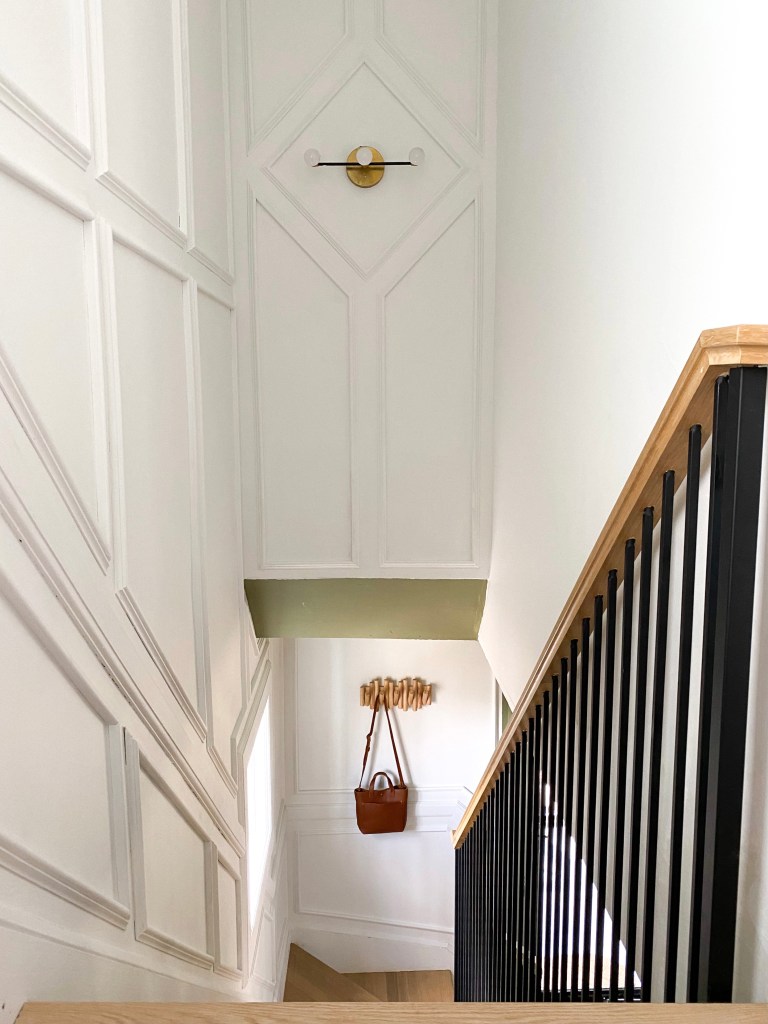
I had known for a while that I wanted to use L.J. Smith products when we would finally tackle the staircase. We had used their cable and tube rail system in our Spring 2020 One Room Challenge renovation and we were absolutely smitten. But, the one thing that was taking me a while to settle on was the style of railing that would effectively marry my modern tastes with the turn-of-the-century character of our home. After much deliberation, I settled on metal newels and balusters with a white oak handrail. The combination was both traditional and modern; classic with a twist. L.J. Smith was incredibly generous to gift us the stair system, and we hope we offered them a final product that meets the incredible standards and integrity of the L.J. Smith stair parts themselves. If interested in using the specific stair parts we used, please find the links to each part here:
The white paint color used throughout the project is Pure White by Sherwin Williams. The green color is Olive by Farrow & Ball.
We first decided on what style newel to use, and I just kept coming back to metal as it is such a classic, yet modern material that has stood the test of time. It was important to me that the metal balusters go directly into the treads with no caps, as that allowed the balusters to have a sleek silhouette that modernized the entire stair system. Though I had nothing against our stairs treads, it would be both easier to achieve this look with new treads and replacing the treads would also allow the white oak handrail to match them. As a quick aside, we have slowly been replacing our downstairs flooring. This process began with the kitchen as we had to remove four layers of floor before being able to lay down a new floor. We went with a white oak herringbone, and will later this year replace the rest of the downstairs with white oak flooring. For now, the stair treads, handrail, and kitchen floor are all matching in a beautiful white oak.
We also decided to get rid of our big bright orange mural that was on the entryway wall and replace it with a whitewashed wall. We then layered two triangular paintings that we created ourselves to mimic the triangular shape of the wall. We painted the custom-made canvases in black and white stripes that mimic the black metal balusters and white walls that are seen between each baluster. The effect is an entryway that is bold yet refined. The black and white theme creates a cohesiveness between the stairway and the entryway, and allows the shapes of the decorative molding, the art, and the stair system to be the focal points.
We were also incredibly fortunate to have been gifted decorative molding for this project by Metrie. We had decided to add decorative molding to the staircase for two reasons. The first of which was to add some visual and tactile interest to the area that would be contemporary with our 1910 home. It truly looks as though it has always been there, and allows the space to be white, bright and airy without being boring. The second reason we added the decorative molding was to highlight the interesting shapes that naturally become an organic part of any stairway. Through the addition of the 3-dimensional molding, attention is drawn to the rhomboids, triangles and trapezoids of the space. Attention is again brought to the interesting angles of the stairway through the custom triangular paintings that were added to the wall below the stairs.

Now, let’s get into how this was all achieved! Replacing treads, and adding a new rail system is not something I would recommend for a DIY newbie, but if you find yourself armed with a bit of experience and are looking for some tips, I hope I can tackle some for you right now. The installation process was really quite simple. We were able to remove the old treads and install the new ones in a matter of two days. One day for demo and one to cut and install the new treads. L.J. Smith had all the measurements ahead of time and so we were already armed with treads that were cut to size, with just minimal cuts needing to be made to the side that fits into the wall.
When installing the treads they need to be cut to size to fit across the two stringers. We only replaced the treads and our existing risers had 3.8” grooves used to joint with the treads. To fit the new treads we had to cut a tongue on the back of the tread to fit the existing groove. This can be easily accomplished by using a router with a straight piece of wood as a guide to get an even trim. The metal newel posts are also easy to install using the LJ Smith system. If you have access to the underside of your stairs like we did it also allows some leeway to adjust the height of the newels before the final install. I would also suggest using some form of laser level as you position the newels and balusters as it will make it easier to line up newel posts at separate ends of the staircase. We used this product linked here.
With the treads and newels installed I wanted a clean look for the metal balusters. This required us to drill out square ½” holes in the treads. To do this we drilled standard round holes and then squared the chisel from a mortise bit to finish off the square hole. This made for a nice clean look with no gaps.

We finished off the entire system with five coats of polyurethane and went through great pains to ensure we would get a finish that would not pull out the yellow tones of the white oak and would have a matte finish. We wanted the wood to be as close to its natural finish and tones as possible. We chose to use a water-based poly since it has much less of an amberizing effect on wood (the yellowing you see when adding an oil based polyurethane to natural wood).
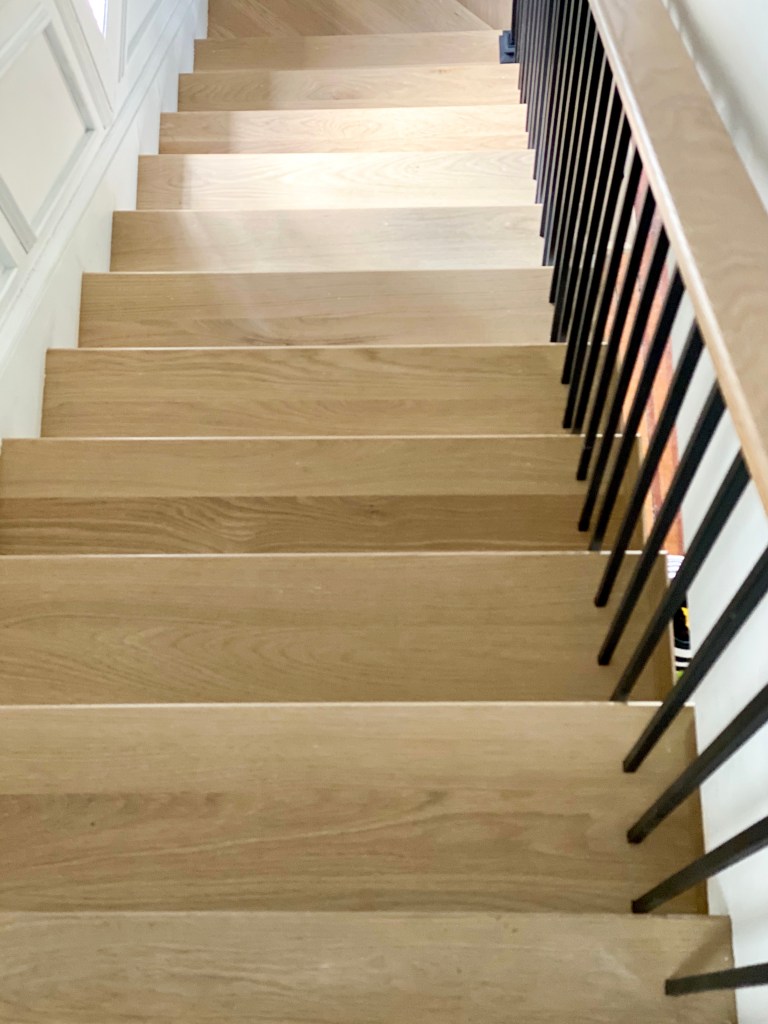
The difficulty was that Varathane does not have a water-based floor poly in a matte finish (at least our local stores did not carry one). Instead we used Varathane’s standard water-based matte polyurethane (the exact product we used can be found here). Finishes that are made for floors are usually thicker given the high foot traffic in such areas. To compensate we did five coats instead of the recommended three. Water-based poly also has a tendency to raise the grain of wood which will result in small bumps noticeable when you run your hand over the dried surface. In order to remove this we did a very light sanding with 220 grit in between the forth and fifth coats.
It feels like such a relief to be done with the stair runner and have beautiful white oak floors revealed. The matte finish gives the stairs more of a grip than a glossier finish, and having the stairs bare allows for much easier clean-ups (a huge plus living in a house with two big dogs and two young kids).

And there you have it! We couldn’t be more excited to finally have our entryway and stair system reflect the aesthetics of the rest of our home. A relatively small project that has made an enormous impact.
And, hopefully, will make a stellar first impression upon entering our home.
XO,





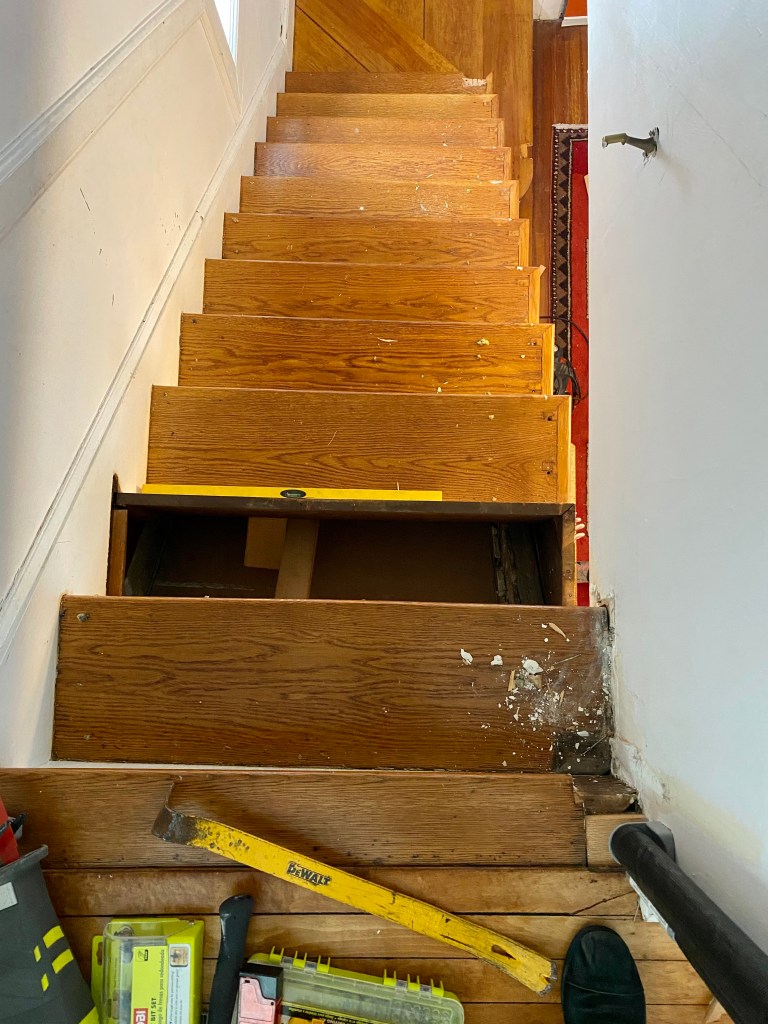
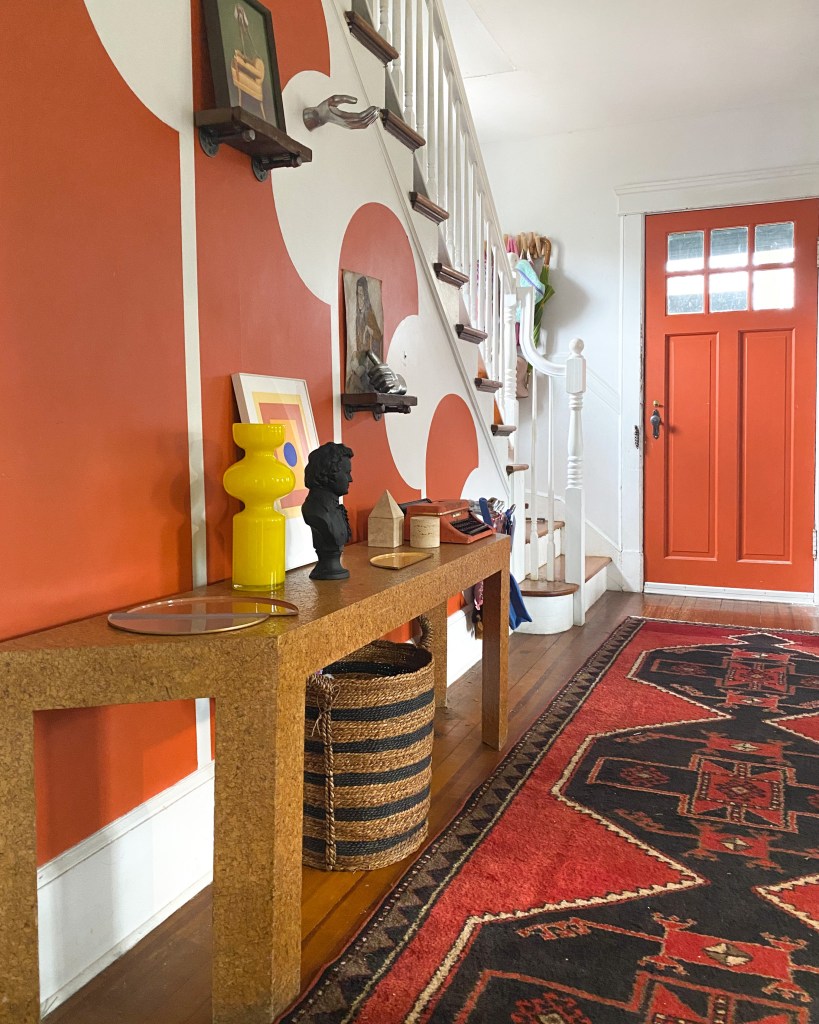
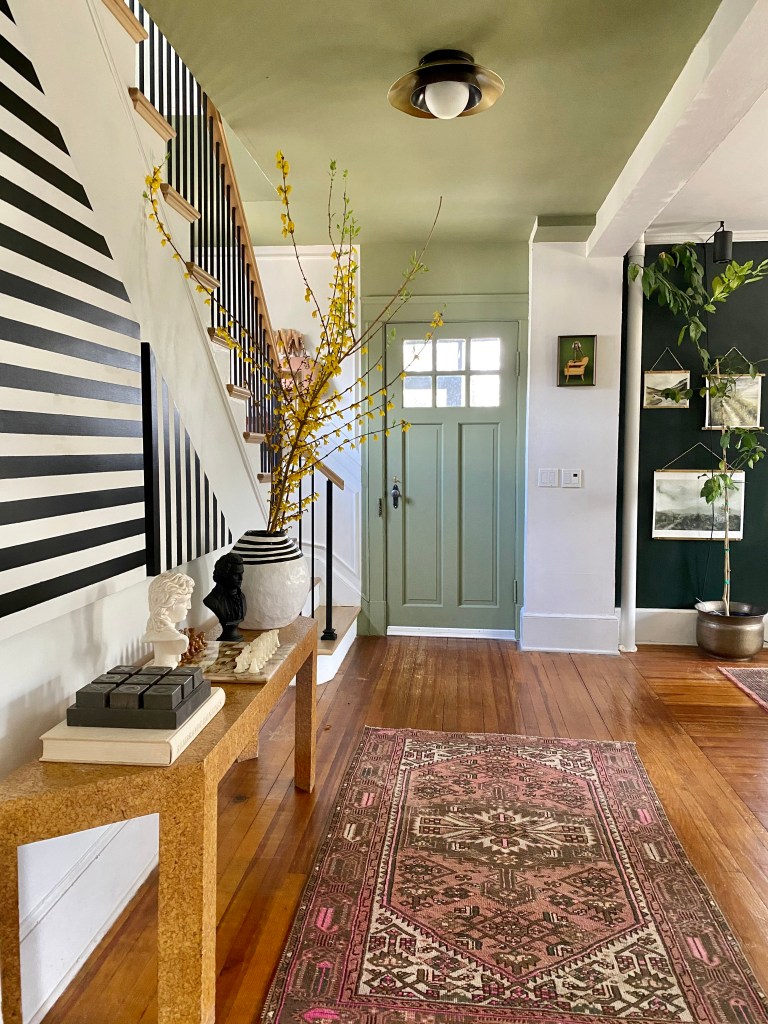

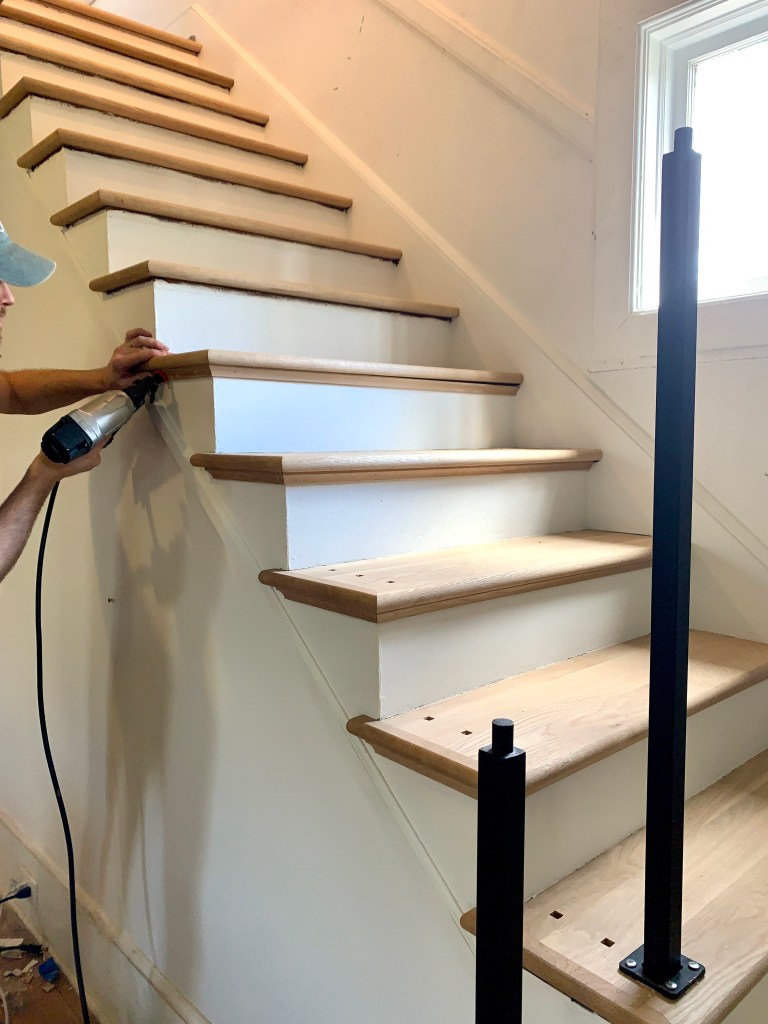
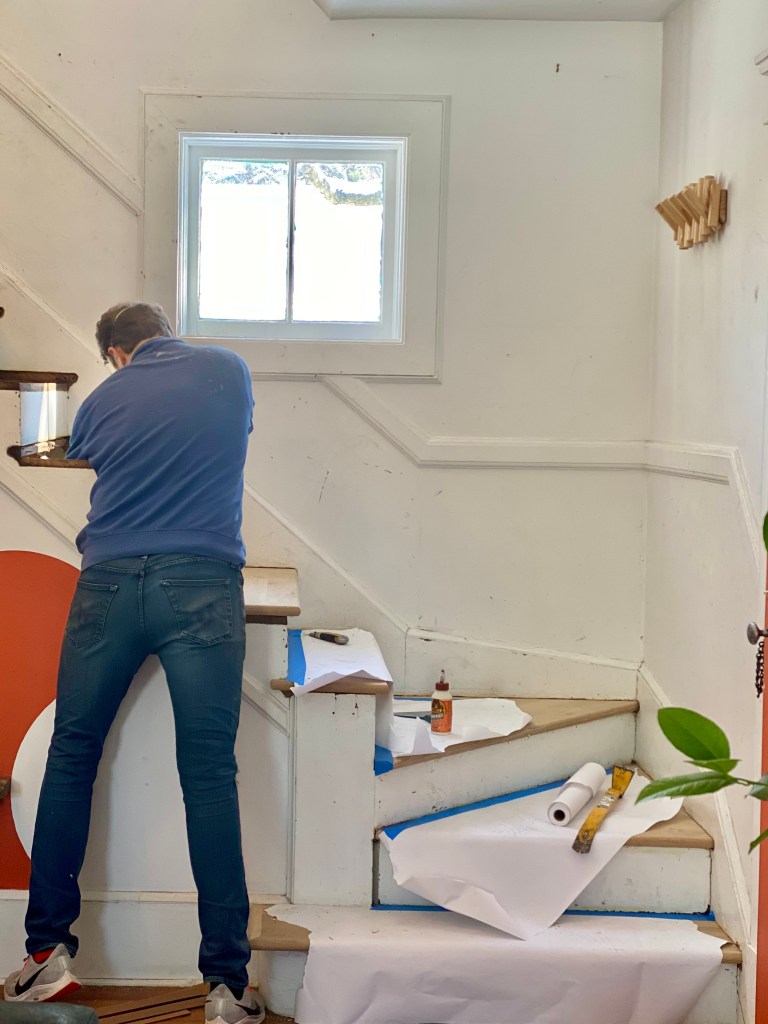


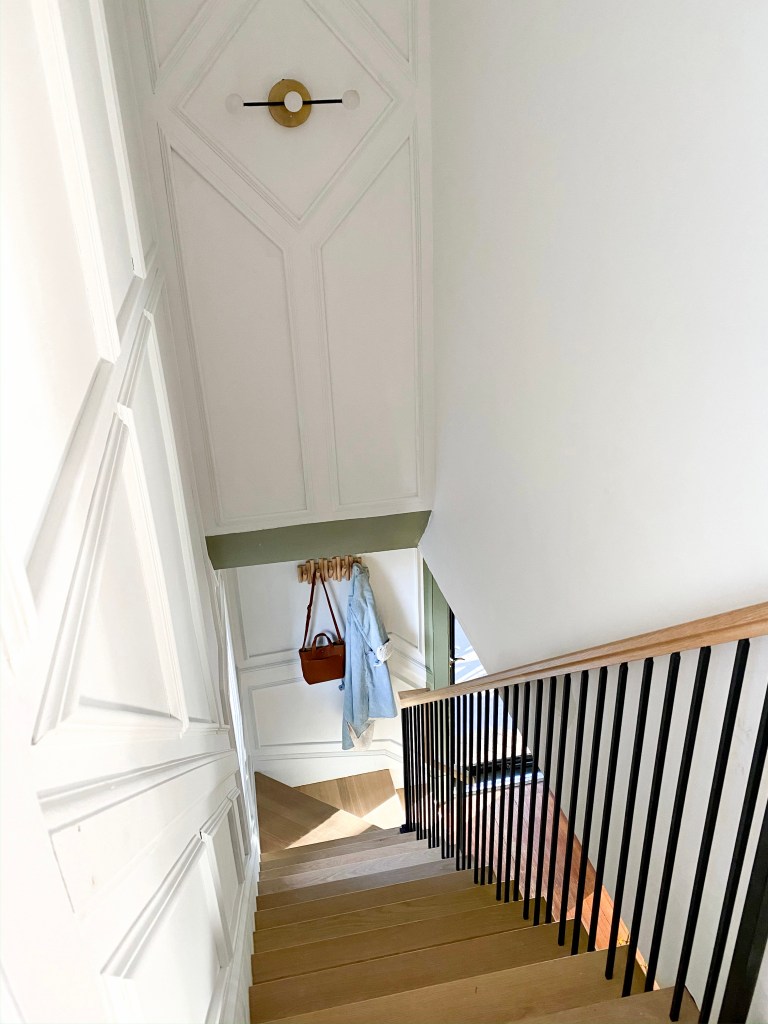


Looks really great, Kate! Thanks for explaining the process.
Thank you so much Brandie! We are very excited about how it all came together.
Gorgeous. What paint colors have you used for your entrance? Love the softened look with the black striping contrast.
Thank you! I used Sherwin Williams Pure White and Farrow & Ball Olive.
This is incredible Kate! Those stairs are perfection. You did it again!
Rebecca! Means the world coming from you, friend! Thank you so much.
I love this SO MUCH and am running to the store to diy some of this stair art. I love it!!!
oh. my. goodness. I’m coming to this post a few months after the fact must say: WELL DONE. The new treads, the rails/balusters, the molding are all wonderful, and the custom canvases are a touch of pure genius. I liked the former orange columns-with-a-swirl-on-top, but the angled stripes are the essence of creativity: they look so simple and do SO MUCH GOOD WORK. As you have done.
Cat! Thank you so much for this – you are very kind to say all of that! ❤️
Do you have a blog about the molding you used on the walls?
I don’t but we’ll be doing some molding projects soon and I will blog about them!
Kate
I love the white oak staircase here. We have honey oak floors throughout our main level, recently refinished. I want to redo our dated stairway. Your thoughts on whether using white oak as you did when the main level pretty much has honey oak. Floors were recently finished and look a bit less golden than before. Our house is 28 years old.
I would have to see the floor to really get a sense of how it would all flow. We were slowly replacing our flooring with white oak and had started with the kitchen and the stairs. I think, ideally, you’ll want your stairs to be a pretty close match to your other flooring but if it’s slightly different but your prefer the white oak, I’d say go for it!